Summary
Public Health England’s (PHE’s) Whole systems approach to obesity: a guide to support local approaches to promoting a healthy weight is a professional resource that is designed to support local action to address obesity. The guide describes a ‘how to’ process, which can enable local authorities, and their partners, to start creating their own local whole systems approaches to reducing obesity and promoting a healthy weight. It can also support local areas who have already started this journey.
Scale of the problem
Excess weight is affected by environmental, societal and individual factors. The scale of the problem and its relationship to a number of diseases is well documented and it is a leading cause of ill-health in England. Local authorities are committed to playing their part in addressing the problem.
The guide is intended to enable local areas and their communities to implement the main principles outlined in What Good Healthy Weight for all ages Looks Like. It will support place-based working to create a whole systems approach to preventing obesity. The identification of locally appropriate actions to include in the approach is supported by Promoting healthy weight in children, young people and families: a resource to support local authorities.
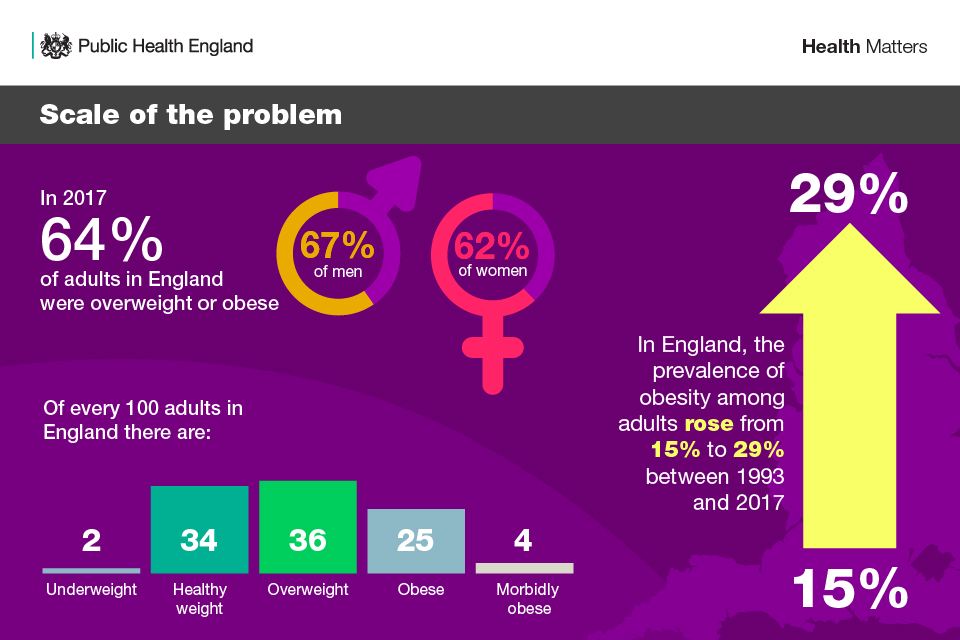

A whole systems approach
There are many different perspectives on what a whole systems approach to obesity is. The following definition, informed by academic thinking and learning from local authorities, was developed through the Whole Systems Approach to Obesity programme, a collaboration between PHE, the Local Government Association, the Association of Directors of Public Health, Leeds Beckett University and local authorities.
“A local whole systems approach responds to complexity through an ongoing, dynamic and flexible way of working. It enables local stakeholders, including communities, to come together, share an understanding of the reality of the challenge, consider how the local system is operating and where there are the greatest opportunities for change. Stakeholders agree actions and decide as a network how to work together in an integrated way to bring about sustainable, long term systems change”.
Taking a whole systems approach to obesity
A growing body of evidence, including Foresight’s Tackling Obesities: Future Choices report, suggests that a whole systems approach could help address complex problems like obesity. An increasing number of local areas across the UK are testing and embedding a systems way of working.
Evidence is also emerging from municipality and community work in the Netherlands and Australia, which supports the benefits of whole systems working. It may also provide a more sustainable approach to addressing obesity – evidence to support this is still emerging.
This edition of Health Matters focuses on taking a whole systems approach to addressing obesity using PHE’s guide and resources, which have been created over the past 4 years in collaboration with local authorities.
The guide describes the ‘how to’ process, which enables local authorities to start creating their own local whole systems approaches to obesity and promoting a healthy weight. It is designed to support local authorities and their local systems partners – the NHS, local businesses, communities and the voluntary sector.
The guide does not specify which specific policies, interventions or actions local areas should include in a whole systems approach. This is an important part of the approach, which needs to be agreed collectively by local stakeholders to reflect the local context. Action planning can be supported by PHE’s Promoting healthy weight in children, young people and families: a resource to support local authorities.
The benefits of a whole systems approach to obesity
A local whole systems approach to obesity is a ‘Health in All Policies’ approach, which draws on local authorities’ strengths, supports their leading priorities, and recognises that they can create their local approaches better and more effectively by engaging with their community and local assets.
Actions to address obesity at a local level do not just benefit people’s health. Delivering a more health-promoting and vibrant environment can contribute to issues like reducing litter and improving the environment and support local businesses and workforces. Maintaining a healthier local workforce may also have positive impacts on other longer term local agendas, including employability and productivity of local populations, and the demand for social care.
It is important to understand these benefits to engage different stakeholders in the whole systems approach. PHE’s Promoting healthy weight in children, young people, and families: a resource to support local authorities can help local areas make the case for action by different stakeholders.
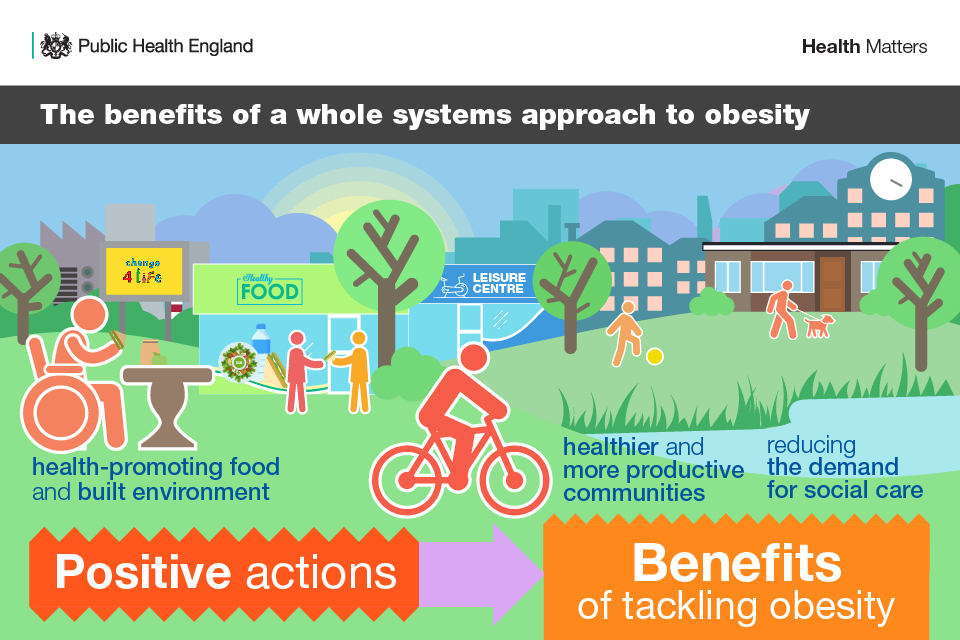
Most local areas interested in setting up a localised whole systems approach will have strategies and programmes of work in place to address obesity. A whole systems approach can add value by providing the opportunity to engage stakeholders across the wider system to develop a shared vision, and include actions that address the causes of obesity outside the realms of public health.
Additional benefits
Taking a whole systems approach can provide additional benefits, over and above the benefits of addressing obesity in general.
Firstly, the effect of collective actions is greater than the sum of individual actions, and the whole systems approach identifies, implements and aligns actions that have a wider impact across the local system.
Secondly, the approach reflects the local leadership role of local authorities, which enables reach and penetration into local places, working with and through an extensive range of stakeholders, including communities.
Thirdly, it aligns with a ‘Health in All Policies’ approach, which recognises the range and complexity of the causes of obesity, and supports a system-wide approach to understanding and addressing health inequalities.
Fourthly, taking a whole systems approach maximises all the assets in the local area, and recognising and identifying local assets can help build on the particular strengths of communities. It supports a community-centred approach to reducing health inequalities, which involves local communities and in particular disadvantaged groups, better reflects the local realities and helps improve health and wellbeing.
Lastly, the approach develops transferable workforce skills and capacity, which are relevant and applicable to other complex issues. It also recognises the potential of all partners that can contribute, including:
- NHS organisations
- local authority departments
- education, business and voluntary sectors
Putting a whole systems approach into practice
To embrace a whole systems approach, it is important to understand how systems function, particularly obesity systems.
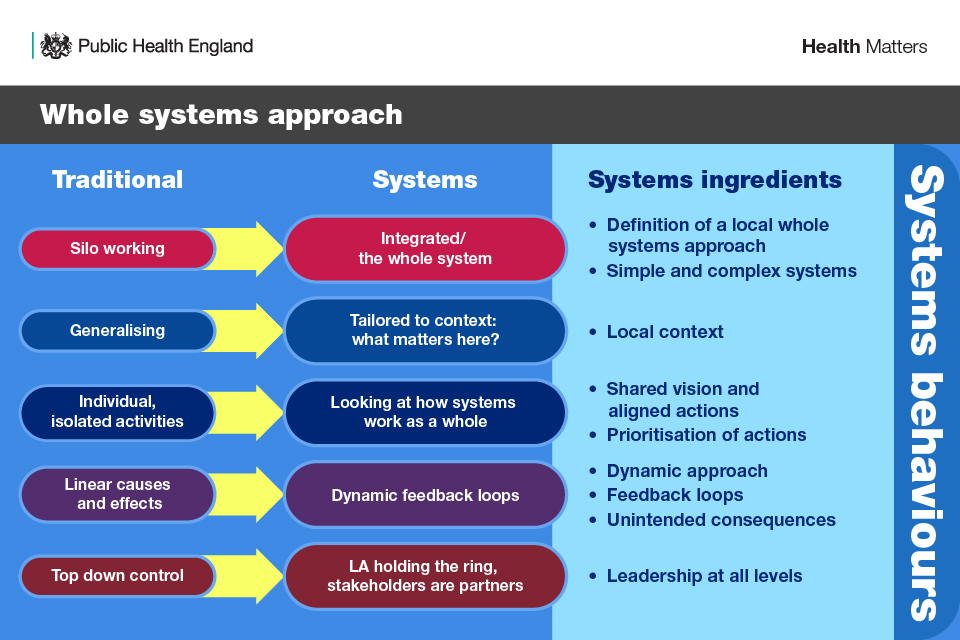
Using a bicycle to understand systems
A system is a collection of interdependent parts. If something happens to one part of the system, other parts of the system will be affected. It is the relationships between the parts that create the system’s function with the whole being greater than, and different from, the sum of its parts.
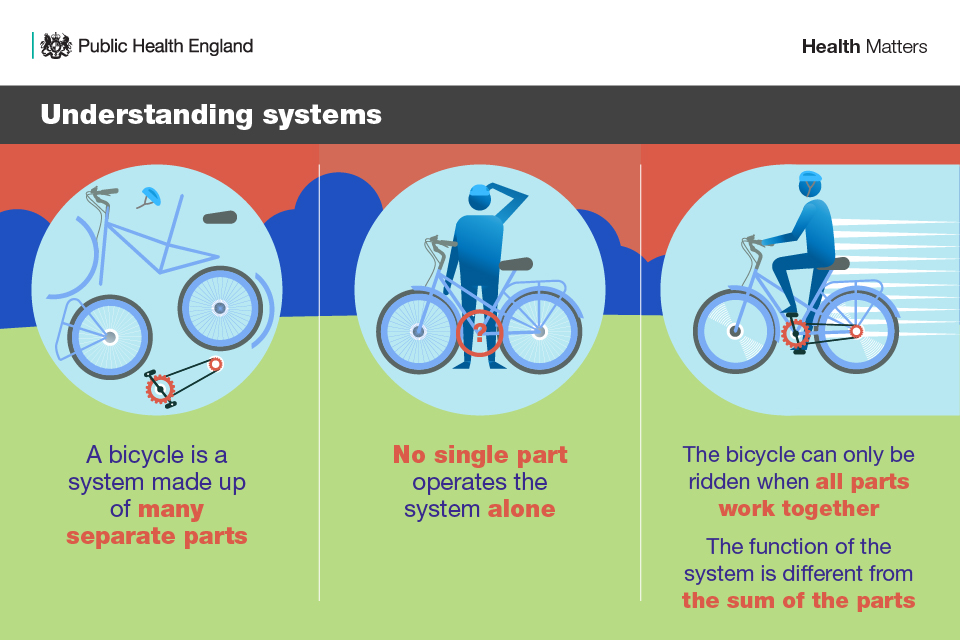
The bicycle infographic above depicts a simple system. Systems are defined as simple when there is a clear cause and effect relationship between the function of the parts and the outcome. Although simple systems can still be complicated, as they are made up of many interacting parts, if individual parts are changed, the likely effect is still predictable.
Conversely, obesity systems are complex with many changing interrelationships. This can be clearly seen in the Foresight Tackling Obesities: future choices system map, which is made up of a series of interconnected ‘sub-systems’: societal and cultural influences, food production, food consumption, biological factors, individual psychology, individual activity and environmental factors. This type of system is a social system because people are involved in, and influence, all aspects of the system. Social systems are always complex and largely unpredictable.
Complex issues tend to require long term, systemic approaches. Securing senior leader buy-in and a change of mindset may be required to commit to this new long-term way of working.
The 6-phase process
The 6-phase process described in the guide can be used flexibly by local authorities, taking into account existing structures, relationships, and actions that are already in place to address obesity. As part of this existing work, some elements of the initial phases in the guide may already be in place. Local authorities are still encouraged to review these phases to ensure the approach is comprehensive and elements such as the narrative about obesity reflect the current local picture.
The process takes stakeholders through 6 phases. The early phases focus on preparation – securing senior leadership support, developing stakeholder groups, building an understanding of the local obesity picture. This is essential to setting up the foundations for the approach.
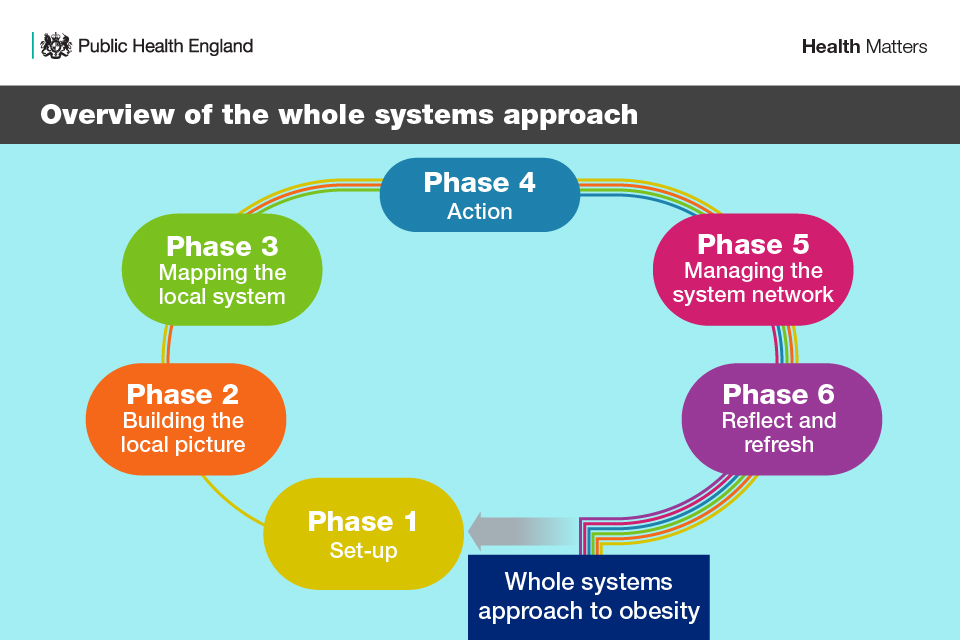
Understanding the local obesity picture could include looking at the prevalence of excess weight in the local area and identifying aspects of the surrounding environment that may be a barrier to achieving a healthy weight. For example, a stocktake of local weight management services or examining planning policies that may be inadvertently allowing a build-up of fast food outlets in an area, or the food offer of local businesses or local authority sponsorship of advertising partnerships that include the promotion of less than healthy food and drink.
Use PHE’s resources including the Local Authority Health Profiles and NCMPand Child Obesity Profile to understand the health for each local authority in England.
The next phases are all about collective working. Stakeholders from across the local system are brought together to create a map of the causes of obesity in their area and identify, prioritise and align areas of action. Collectively mapping the local system of obesity causes is fundamental to the whole approach – it enables stakeholders to recognise their role in the system and how they can make a difference. It also highlights how different actions can be aligned so everyone is working in the same direction.
Maintaining momentum and focusing on taking actions forward as a group is at the heart of creating and refreshing a dynamic local systems approach. Critical to this is continuous monitoring and reflecting on how actions and the approach can be improved and adapted.
Read the full whole systems approach to obesity guide for detailed support with each phase of the process.
Shared vision and aligned actions
Developing a shared vision will unite stakeholders with different backgrounds and agendas, to form a common aspiration. A clear vision allows stakeholders to stay focused and move forward in the same direction and helps everyone to see how their work fits in.
A whole systems approach enables collective efforts and alignment of actions. Stakeholders consider the range of required actions to address obesity and promote a healthy weight together rather than considering individual actions in isolation. This enables different parts of the system to move forward together, maximising synergies and creating a more impactful approach.

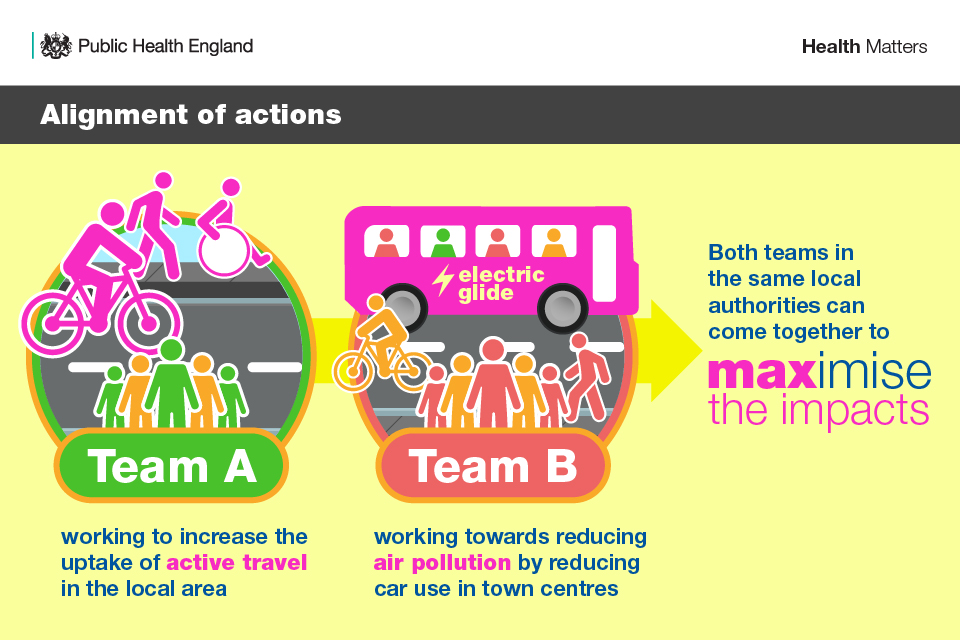
Leadership buy-in and resource
For many local areas adopting a whole systems approach is a new way of working that requires commitment, energy, drive and importantly, local political and senior level buy-in.
Having the sustained, visible and active support of elected members, the chief executive, and senior leaders sends a clear signal that addressing obesity is a priority for the whole local authority, not just public health, and its wider stakeholders.
It will also help to ensure that time, resource and commitment continue as a whole systems approach will require ongoing administrative resource to maintain momentum.

The role for systems partners
It will take time to implement a whole systems approach to obesity. The expected time frames to achieve outcomes from collective actions and different ways of working must be realistic and considered throughout the cycle of reflection. It is vital to harness a collective effort over the long term to create a whole systems approach.
It is clear that no one organisation has all the answers or all the responsibility to deal with obesity and promote a healthy weight. It is ‘everybody’s business’. A whole systems approach enables local leadership, across stakeholders inside and outside the local authority, and communities, and can help make a difference to how obesity and its causes are dealt with.
PHE’s Promoting healthy weight in children, young people, and families: a resource to support local authorities can help public health teams make the case for cross-system action by providing briefings for different stakeholders inside and outside the council.
The role for the NHS
There are various opportunities through the NHS and its commissioned services to promote healthy weight across the life course. The Childhood Obesity Plan recognises that the NHS has an important role in addressing childhood obesity at both a local and national level.
Lifestyle behaviour interventions are important to help individuals and families on a healthier weight journey. However, this is not sufficient to deal with the issues at a population level. A collaborative whole systems approach is likely to be more effective to promote healthy weight in children, young people, and families rather than single interventions on their own.
Local partnerships could include Integrated Care Systems, Integrated Care Partnerships, Accountable Care Organisation, Primary Care Networks, voluntary sector, local communities, and local businesses.
The NHS, as one of the largest employers in England, has a role to play in keeping its staff healthy by:
- improving the quality of food outlets on hospital sites
- implementing regular meal break times
- initiatives that promote active travel to work
- supporting staff, who may benefit, access lifestyle behaviour services including weight management services
Community engagement
Involving local communities in the approach will help ensure that the resulting programme of work takes account of the views, knowledge and priorities of the communities who are, ultimately, the beneficiaries of whole system efforts to address obesity.
Communities can be engaged in the whole systems approach by:
- involving them in every aspect of your whole systems work to benefit from their expertise in what people in the community want, what they consider to be their assets and how efforts to intervene might be made more effective
- allocating sufficient time, energy and resource to build strong, long-lasting relationships with community members and organisations
- choosing from the family of community engagement approaches at each stage and engaging at a level that is appropriate to the task, the history of community engagement in your area and the expertise available to you and your partners
- seeking their support for emerging priorities – listen to the views of your local communities and learn from them to help you find common priorities to take forward
Engaging communities in the whole systems approach can also help identify population groups at increased risk of overweight and obesity and therefore help address health inequalities.
Community-centred ways of working are important for addressing not just obesity but for all aspects of public health, including health improvement, health protection, and healthcare public health.
Article Source: https://www.gov.uk/government/publications/health-matters-whole-systems-approach-to-obesity/health-matters-whole-systems-approach-to-obesity
